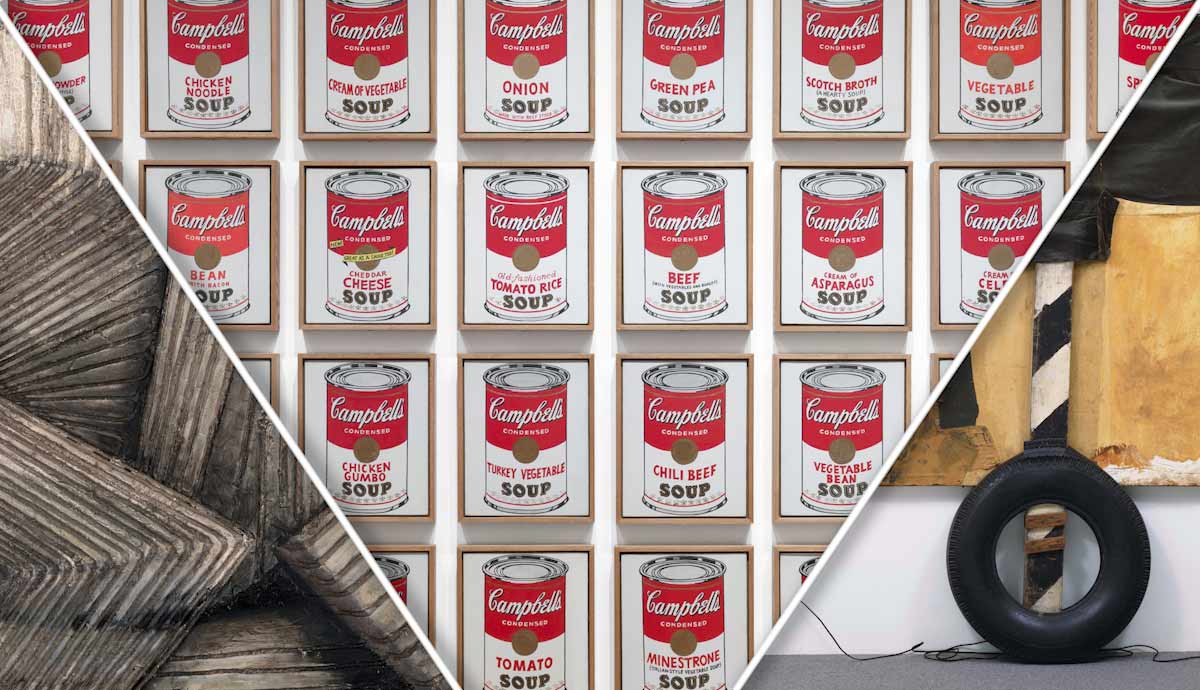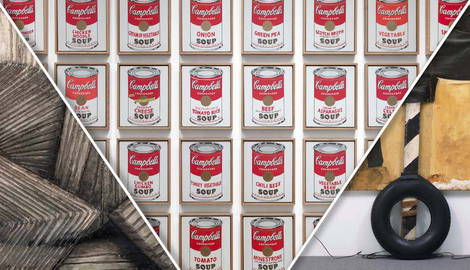
Marcel Duchamp left a lasting mark on art history and many modern and contemporary artists. Duchamp was not concerned with creating a lot of artworks. Instead, he would spend several years studying and working on one piece. He also never refused to help other artists. Duchamp was interested in other people’s art, he helped artists gain recognition and participated in various group exhibitions. Here is a list of 9 artists who were inspired by the works of Marcel Duchamp.
1. John Covert

John Covert was born in Pittsburgh, United States. He was a founding member of the Society of Independent Artists and a Dadaist painter.
Covert probably met Marcel Duchamp in the Arensberg circle in New York. Covert, who was also Walter Arensberg’s cousin, was among the frequent attendees of their meetings, alongside Joseph Stella, Charles Sheeler, Man Ray, and numerous poets and writers. He quickly befriended Duchamp and became one of the first artists who were inspired by his works.
Although his whole artistic identity can be associated with Marcel Duchamp’s ideas, historians particularly link Covert’s Brass Band to Duchamp’s Chocolate Grinder (No. 2). The two works both look alike, with their cylindrical, interlocking shapes and were executed using the same technique—by gluing stretched string to cardboard. Another notable work signed by John Covert called Time may have also been inspired by Duchamp’s mathematical, mechanical thinking, as its notations refer to complex formulas. The work called Water Babies, which depicts two dolls, one of which is submerged in a water container, was also inspired by Duchamp and Picabia.
2. Joseph Stella

Joseph Stella was an American painter born in Italy. His artworks are now widely recognized as Futurist and he is best known for the ways in which he portrayed industrial America. His paintings showing the Brooklyn Bridge are probably his most famous works.
Like John Covert, Joseph Stella met Duchamp at the Arensberg meetings. He became a close friend of his and even accompanied him to the plumbing store where Duchamp bought the urinal that would soon become the most famous artwork of the 20th century called Fountain. After seeing Duchamp’s work on glass in his studio, Joseph Stella was inspired to paint on glass as well. Stella was also very passionate about collages. Although historians believe that Stella was majorly influenced by the German artist Kurt Schwitters, Duchamp’s ideas also contributed to his dedication to collages.
3. Man Ray

Man Ray was a visual artist born in America who spent most of his life in Paris. He contributed to both Dada and Surrealism. Like others on this list, Man Ray was introduced to Marcel Duchamp by Walter Arensberg after the exhibition where the famous Nude Descending a Staircase, No. 2 was displayed at the New York Armory Show in 1913. This was the beginning of a long-lasting friendship.
Man Ray immediately noticed Duchamp’s expert way of depicting movement. He soon started implementing the painter’s ideas in his own works. For example, The Rope Dancer Accompanies Herself with Her Shadows clearly shows Duchamp’s influence if we look at the repetitive positions.
Duchamp’s readymades also left a mark on Man Ray. Soon after seeing his friend’s artwork, Man started making readymades himself. He created a piece called Gift which featured an iron with sharp tacks glued to its bottom surface. He also produced replicas of Duchamp’s readymades. Man Ray also had the opportunity to work with Duchamp on several occasions. He helped Duchamp create Rotary Glass Plates and he also made dozens of portraits of the French artist, including the famous Rrose Selavy portrait which is a part of the Belle Heleine, Eau de Voilette readymade.
4. Joseph Cornell

Joseph Cornell was an American visual artist. He was famous for his assemblages and was primarily influenced by Surrealism. Cornell was also an experimental filmmaker. Much younger than Duchamp, Cornell saw him as a mentor, although the two did not meet until 1933.
During the 1940s, however, Joseph Cornell asked Duchamp to visit his studio. By agreeing to see him, Duchamp set in motion a close friendship with the younger artist, who, over the years, was greatly influenced and helped by Marcel Duchamp. According to Calvin Tomkins, Duchamp was quite impressed with Cornell’s work and he supported him with advice and persuaded art dealers to buy several of his works. The younger artist even helped Duchamp assemble Boîte-en-valise. Their works were slightly different in tone—Duchamp favored the cool and the indifferent, while Cornell went for the nostalgic—but they also bear noticeable similarities.
5. Jasper Johns

Jasper Johns is an American painter and sculptor whose work is connected to Neo-Dada, Abstract Expressionism, and Pop Art. Johns met Duchamp in 1960 and continued to see him regularly afterward. One of his most famous works paying homage to Duchamp is According to What from 1964. This is a large painting made on several canvases put together. Johns added several real objects to the canvas. As an ode to Duchamp, Johns added his silhouette on the far left. The artwork closely resembles Marcel Duchamp’s Tu m’, which was the last painting on canvas the French artist ever made.
6. Andy Warhol

Andy Warhol is perhaps the most devoted practitioner of Marcel Duchamp’s concepts. In fact, the Andy Warhol Museum held an exhibition dedicated to the relationship between the two artists. During his life, Warhol bought over 30 works signed by Duchamp.
When looking at Andy Warhol’s creations you can instantly notice Duchamp’s influence. For example, Duchamp appropriated the Mona Lisa in his famous work L.H.O.O.Q, while Warhol did the same in Two Golden Mona Lisas. Warhol didn’t stop here though, he repeatedly reappropriated various classical artworks and offered them a revised cultural definition. For instance, he gave the Roman goddess of love, Venus, a dark complexion and bright red hair, making her look like a modern pop singer. Also inspired by Duchamp’s Wanted: $2,000 Reward, Warhol produced his Most Wanted Men series.
Warhol’s fascination with Duchamp’s readymades gave birth to several famous artworks that challenged the traditional definition of art. For example, Warhol took the Brillo boxes from the grocery store to the art galleries. He did the same with his famous Campbell’s Soup Cans when he used 32 canvases to show images of soup cans found in everyday life. Duchamp himself commented on this artwork by saying: “If you take a Campbell soup can and repeat it 50 times, you are not interested in the retinal image. What interests you is the concept that wants to put 50 Campbell soup cans on a canvas.”
7. Richard Hamilton

Richard Hamilton was a painter and collage artist. He was, perhaps, England’s most famous practitioner of Duchampian concepts. Hamilton dedicated much of his time to studying Duchamp’s work, particularly the Green Box which he tried to translate and decipher. Green Box contained all the notes related to The Large Glass. Hamilton even taught a lecture on it. Hamilton also recreated Duchamp’s The Large Glass in precise detail. The original author was impressed by the reconstruction and even signed the artwork.
8. Robert Rauschenberg

The American painter and graphic artist Robert Rauschenberg carried on Duchamp’s legacy until he died in 2008. Like Johns, Rauschenberg sought to make his art part of the real world rather than an imitation of it by creating artworks using various everyday objects like rocks, dirt, grass, mirrors, and Coca-Cola bottles.
Rauschenberg met Duchamp in 1960 and ended up admiring him so much that he executed an artwork as a homage to him just like Johns. It was called Trophy II (for Teeny and Marcel Duchamp) and again, much like Johns’ piece, was done using a combination of techniques and materials including oil, charcoal, printed paper, and sheet metal. A year after meeting Duchamp, Rauschenberg created First Landing Jump, for which he used a tire, thus alluding to a preference for urban everyday materials. Art critics believe that he was influenced by Duchamp’s Bicycle Wheel. The whole concept of readymades seemed to have appealed to Rauschenberg. Its influence can be repeatedly seen in Rauschenberg’s combines, as he called them. They are a combination of painting and sculpture made using various mundane objects. In some, for example, Rauschenberg even used taxidermied animals.
9. Marcel Duchamp of Contemporary Art: Maurizio Cattelan

Maurizio Cattelan is an Italian visual artist who is probably best known for his sculpture America, which clearly refers to Duchamp’s Fountain. Just like Duchamp, Cattelan uses humor and satire when producing his artworks. He has even been called a “great post-Duchampian artist.”
America, a fully functional golden toilet, was first exhibited at the Solomon R. Guggenheim Museum in New York in one of the museum’s bathrooms. Although a controversial work, much like Duchamp’s Fountain, America brought thousands of visitors to the museum, who waited in line to see it. A few years later after its first exhibition, America was installed at Blenheim Palace in a water closet that had once been used by Winston Churchill. Shortly after, however, it was stolen, and Catellan approached the theft with humor, saying: “I always liked heist movies and finally I’m in one of them.”









